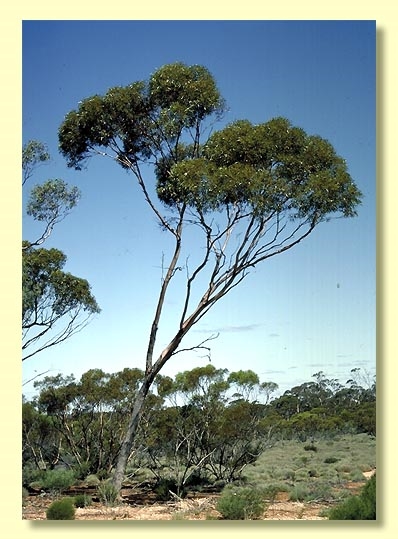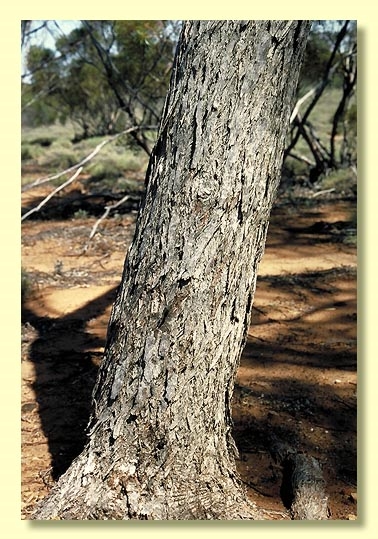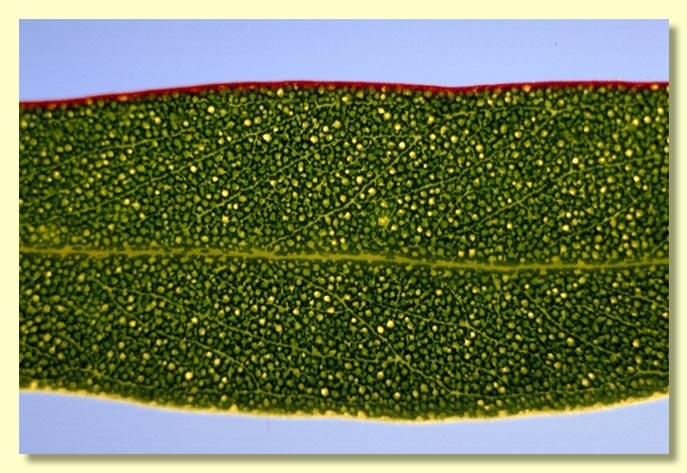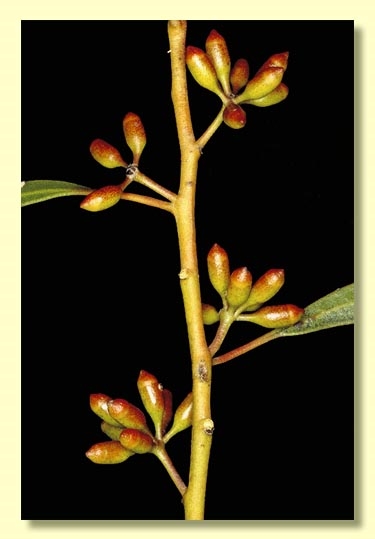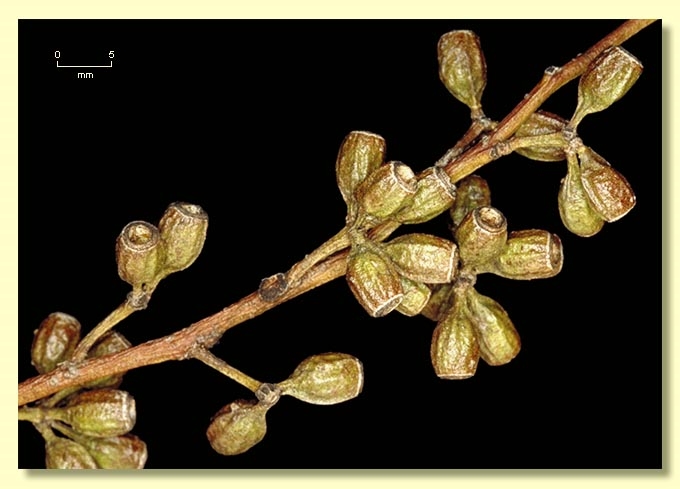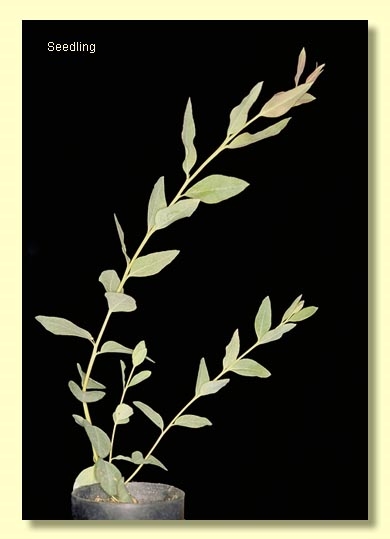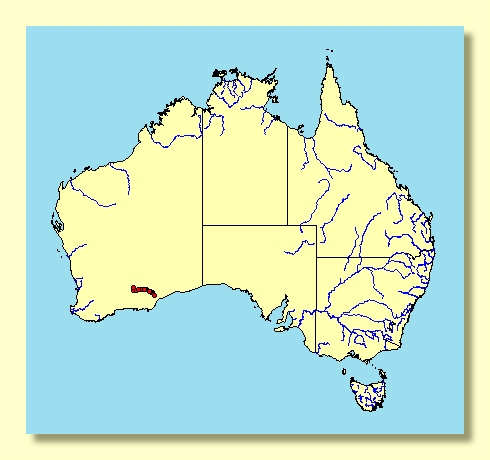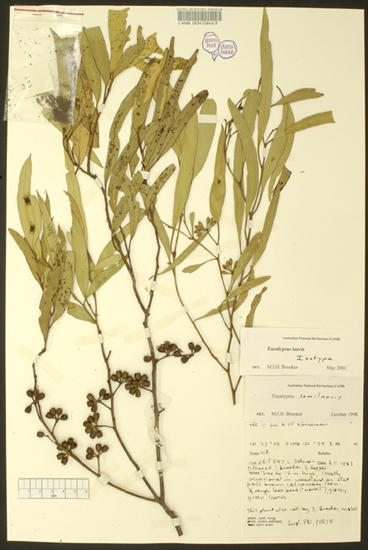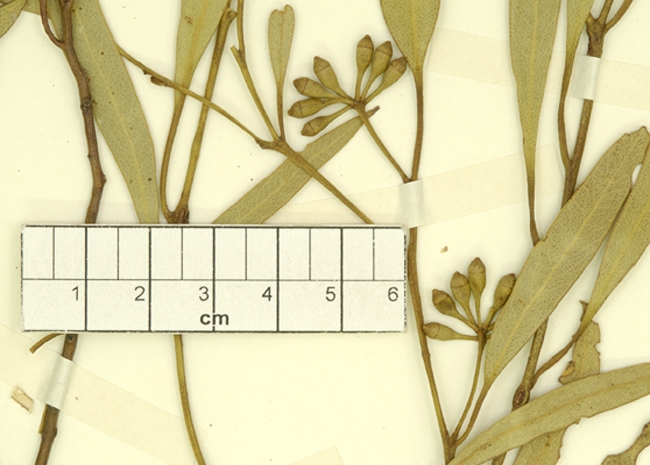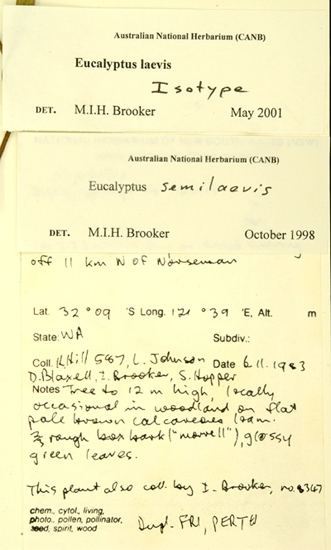Eucalyptus | Symphyomyrtus | Dumaria | Corrugatae
Euclid - Online edition
Eucalyptus laevis
Bark rough over part or all of trunk, thin, shaggy and scaly or flat with shallow fissures, blackish and orange-brown, smooth above, grey to pale grey and orange to salmon-pink.
Branchlets with oil glands in the pith.
Juvenile growth (coppice or field seedlings to 50 cm): stems square in cross-section, slightly glaucous; leaves always petiolate but shortly so, opposite for ca 3 nodes then alternate, lanceolate, 6.5–9 cm long, 0.9–2 cm wide, dull, blue-grey or slightly glaucous.
Adult leaves alternate, petioles 0.8–1.5 cm long; blade linear to narrowly lanceolate, 6.5–10.5 cm long, 0.5–1(1.4) cm wide, base tapering to petiole, margin entire, apex finely pointed (drip tip), concolorous, glossy, green, side-veins at an acute or wider angle to midrib and densely reticulate or side-veins and reticulation obscured by numerous island oil glands, intramarginal vein close to margin.
Inflorescence axillary unbranched, peduncles 0.5–1.5 cm long, buds ? to 11 per umbel, pedicellate (pedicels 0.2–0.4 cm long). Mature buds cylindrical (0.6–0.9 cm long, 0.3–0.4 cm wide), scar present, operculum rounded, sometimes apiculate, to broadly conical (0.2–0.4 cm long), stamens inflexed, anthers oblong to wedge-shaped, versatile, dorsifixed, dehiscing by longitudinal slits, style long and straight, stigma blunt to slightly rounded, locules 3, the placentae each with 4 vertical rows of ovules. Flowers white.
Fruit pedicellate (pedicels 0.2–0.4 cm long), cylindrical to barrel-shaped, 0.5–0.8 cm long, 0.4–0.6 cm wide, disc descending vertically, valves 3, near rim level or enclosed.
Seeds brown or blackish, 1–2.3 mm long, ovoid or flattened-ovoid, dorsal surface pitted, margin ragged, hilum ventral.
Cultivated seedlings (measured at ca node 10): cotyledons reniform; stems square in cross-section; leaves always petiolate, opposite for 5 or 6 nodes then becoming alternate, ovate to lanceolate, 3.5–6.5 cm long, 1.5–2.5 cm wide, dull, bluish green to slightly glaucous.
Flowering time unknown.
Mallee or small tree endemic to Western Australia, found in the Norseman–Balladonia area on calcareous loamy soil. Bark is rough, pale grey and shaggy on at least part of the trunk and the leaves glossy green.
Eucalyptus laevis is a recently described species belonging to Eucalyptus subgenus Symphyomyrtus section Dumaria because the buds have two opercula, stamens are strongly inflexed, ovules are in four rows on the placentae and cotyledons are reniform. Within this larger grouping E. laevis and six other species—E. corrugata, E. melanoxylon, E. concinna, E. brachycalyx, E. griffithsii and E. rugosa—form a sub-group called series Corrugatae, all with ovoid, conspicuously pitted seeds and with dark brown oil glands in the pith of the branchlets.
Eucalyptus laevis is distinguished from other species in series Corrugatae by having cylindrical buds in clusters of up to eleven, a conical operculum, cylindrical to barrel-shaped fruit and the rough-barked trunk. Superficially the fruit may be confused with those of the more distantly related E. cylindrocarpa; however, that species usually has buds with a beaked operculum, seeds with a shallow but clearly reticulate surface rather than pitted, and smooth-barked stems.
The limits of distribution of E. laevis are poorly known.

